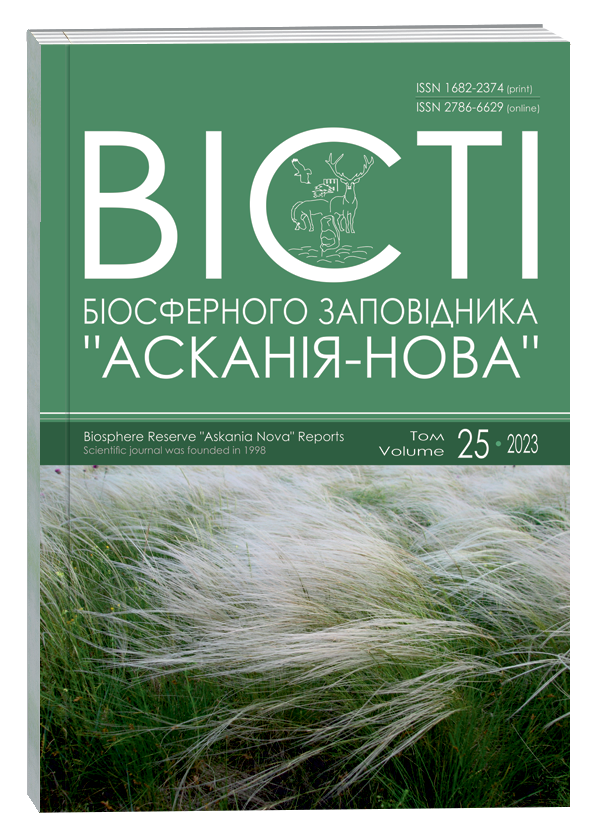GRAFTING AS AN EFFECTIVE METHOD OF PLANT PROPAGATION GINKGO BILOBA L. DIFFERENT CULTIVARS
DOI:
https://doi.org/10.53904/1682-2374/2023-25/14Keywords:
Підщепа, прищепа, щеплення у приклад, щеплення у розщіп, окулірування у прикладAbstract
The aim of the study was to find out the optimal timing and methods of grafting plants of different cultivars of Ginkgo bi-loba L. in open and closed soil conditions. Its cultivars were propagated using the following methods of grafting for conifers: spring grafting (copulation) – by the core of the cutting on the rootstock cambium, by the cambium on the cambium and in the split of the apical-wedge, as well as summer grafting – budding on the cutting. Compared to other methods of propagation, grafting has such advantages as preserving varietal characteristics, accelerating the onset of fruiting, enhancing growth, adjusting size (habitus), increasing the resistance of grafted plants to diseases and pests, and the ability to combine several scions on one plant to form a "tree garden." In the case of spring grafting, under controlled in-door conditions, the scion fused with the G. biloba rootstock within three weeks of the start of the ex-periment, and in the case of summer grafting – in the spring of the following year. The most effective and simple method of grafting into the apical-wedge split with a survival rate of 95.2–96.8% was found to be the most effective and easy to perform. The effectiveness of propagation by copying the cuttings into the butt with the core of the cuttings on the rootstock cambium was 87.6–89.6%, in the butt with the cambium on the cambium – 58.9–67.7%, and in the butt with budding – 68.4%. It has been shown that the timing of grafting of G. biloba cultivars does not affect the quality of rootstock and scion engraftment. Successful grafting of G. biloba cultivars requires controlled indoor soil conditions.
References
Ботанічний сад Житомирського національного агроекологічного університету: інформ.-довід. путівник / Іванюк Т. М. та ін.; за ред. Л. В. Михайловського. Житомир : Житомирський національний агроекологічний університет, 2013. С. 149–150.
Глухов О. З., Довбиш Н. Ф., Хархота Л. В. Прискорене вегетативне розмноження Ginkgo biloba L. на Південному Сході України. Бюллетень Никитского ботанического сада. 2008. Вып. 96. С. 35–37.
Грабовий В. М. Вегетативне розмноження модрини за допомогою щеплення. Науковий вісник НЛТУ України. 2011. Вип. 21.13. С. 35–39.
Дендрофлора України. Дикорослі та культивовані дерева й кущі. Голонасінні: Довідник / за ред. М. А. Кохна, С. І. Кузнецова. Київ : Вища школа, 2001. 207 с.
Каталог растений (деревья, кустарники, многолетники, рекомендованные Союзом Польских Питомников) / гол. ред. Joanna Filipczak. Warszawa, Polska: Agencja Promocji Zieleni Sp. z o.o., 2013. С. 26–29.
Ліберт Н. Є. Парк КПІ: дендрологічний путівник територією КПІ ім. Ігоря Сікорського: наук.-попул. вид. Київ : КПІ ім. Ігоря Сікорського, вид-во "Політехніка", 2019. 68 с.
Остудімов А. О. Гінкго дволопатеве в Україні: насінний потенціал, особливості вирощування та використання садивного матеріалу : автореф. дис. … канд. с.-г. наук : 03.00.16. Львів, 2011. 20 с.
Остудімов А. О., Гузь М. М. Особливості насінного розмноження гінкго дволопатевого. Науковий вісник НЛТУ України. 2010. Вип. 20.11. С. 8–16.
Остудімов А. О., Мандзюк Р. І., Гузь М. М. Гетеровегетативне розмноження гінкго дволопатевого. Науковий вісник НЛТУ України. 2010. Вип. 20.12. С. 53–58.
Рекомендації зі створення лісонасінної бази найперспективніших інтродуцентів деревних рослин / уклад. : Лось С. А., Орловська Т. В., Григорьєва В. Г. Харків, 2008. 34 с.
Самородов В. Н., Чеботарева Л. В. Лектины гинкго двулопастного (Ginkgo biloba L.): итоги предварительных исследований. Лекарственное растениеводство: от опыта прошлого к современным технологиям: материалы второй Международной научно-практической интернет-конференции. Полтава, 2013. С. 137–139.
Сініціна Л. В. Біоекологічні особливості Ginkgo biloba L. в умовах девастованих ландшафтів : автореф. дис. … канд. біол. наук : 03.00.05. Київ, 2002. 21 с.
Терещук А. І. Гінкго-цілитель. Українські народні звичаї. Видання 2-ге, доп. та перероблене. Київ : Логос України, 2009. 160 с.
Цибровська Н., Грабовий В. Початкові етапи онтоморфогенезу сіянців Ginkgo biloba L. в умовах Національного дендрологічного парку "Софіївка" НАН України. Journal of Native and Alien Plant Studies. 2020а. С. 194–204.
Цибровська Н. В., Грабовий В. М. Морфометрична характеристика та ґрунтова схожість насіння Ginkgo biloba L. отриманого в умовах Степової та Лісостепової зон України. Фундаментальні та прикладні аспекти інтродукції рослин в умовах глобальних змін навколишнього середовища: матеріали міжнародної наукової конференції, присвяченої 85-річчю від дня заснування Національного ботанічного саду імені М. М. Гришка НАН України, 22–24 вересня 2020 р. Київ, 2020б. С. 189–193.
Цибровська Н. В., Грабовий В. М. Колекція сортів Ginkgo biloba L. у Національному дендрологічному парку "Софіївка" НАН України. Тернопільські біологічні читання – Ternopil Bioscience – 2023: матеріали Міжнародної науково-практичної конференції, присвяченої 100-річчю від дня народження відомої вченої-ботаніка к.б.н., доц. Валентини Омелянівни Шаманської, 11–13 травня 2023 р. Тернопіль : Вектор, 2023. С. 80–84.
Шляхта І. М., Лисюк Р. М. Гінкго дволопатеве – унікальне цілюще дерево. Квіти України, 2016. № 6 (154). С. 18–20.
Browse Ph. McM. Plant Propagation: seeds, roots, bulbs and corms, layering, stem cuttings, leaf cuttings, budding and grafting. London : Mitchell Beazley, 1985. P. 87–93.
Del Tredici Peter. The evolution, ecology, and cultivation of Ginkgo biloba. Ginkgo biloba. Australia, Canada, France, Germany, India, Japan, Luxembourg, Malaysia, The Netherlands, Singapore, Switzerland : Harwood academic publishers, 2000. P. 7–23.
Kosenko I. S., Tsybrovska N. V., Balabak O. A., Hrabovyi V. M., Muzyka H. I., Shvets T. A., Oksantiuk V. M. Introduction of Ginkgo biloba L. and its cultivars by vegetative propagation. Ukrainian Journal of Ecology. 2021. Vol. 11(7). P. 65–76. https://doi.org/10.15421/ 2021_243
Lewis W. J., Alexander D. McE. Grafting & Budding. A Practical Guide for Fruit and Nut Plants and Ornamentals. 2nd edition. Australia : Landlinks Press, 2008. P. 19–21.
Han-Yang Lin, Wen-Hao Li, Chen-Feng Lin, Hao-Ran Wu, & Yun-Peng Zhao. International Biological Flora: Ginkgo biloba. Journal of Ecology. 2021. No 2. P. 951–982. https://doi.org/10.1111/1365-2745.13856
Rasheid Najma, Sofi P. A., Masoodi T. H. Effect of IBA on rooting and seedling growth of Ginkgo biloba L. stem cuttings under temperate conditions of Kashmir. Chemical Science Review and Letters. 2018. Vol. 7(26). P. 485–489.
Shehla Noreen, Faheem Aftab. Softwood shoot forcing from epicormic buds of Ginkgo biloba L. Propagation of Ornamental Plants. 2021. Vol. 21. No 3. P. 88–95.
Šmarda P., Horová L., Knápek O., Dieck H., Dieck M., Ražná K. … & Bureš P. Multiple haploids, trip-loids, and tetraploids found in modern-day "living fossil" Ginkgo biloba. Horticulture Research. 2018. 5: 55. 12 p. https://doi.org/10.1038/s41438-018-0055-9
Tang C. Q., Yang Y., Ohsawa M., Yi Si-Rong, Momohara A., Su Wen-Hua … & Wu Zhao-Lu. Evidence for the persistence of wild Ginkgo biloba (Ginkgoaceae) populations in the Dalou Mountains, southwestern China. American Journal of Botany. 2012. Vol. 99, No 8. P. 1408–1414.







